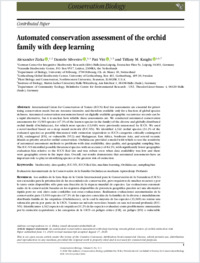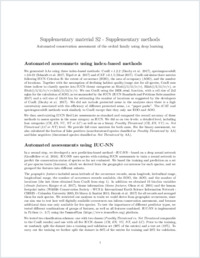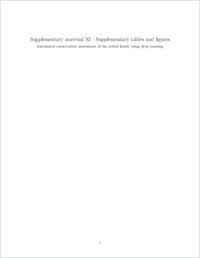Automated conservation assessment of the orchid family with deep learning
- Zizka, Alexander German Center for Integrative Biodiversity Research (i, Div) Halle‐Jena‐Leipzig Deutscher Platz 5e Leipzig 04103 Germany - Naturalis Biodiversity Centre P.O. Box 9517 Leiden 2300RA the Netherlands
- Silvestro, Daniele Department of Biology University of Fribourg 1700 Fribourg, Ch. de Musee 10 Switzerland - Gothenburg Global Biodiversity Center University of Gothenburg Box 461 Gothenburg 405 30 Sweden
- Vitt, Pati German Center for Integrative Biodiversity Research (i, Div) Halle‐Jena‐Leipzig Deutscher Platz 5e Leipzig 04103 Germany - Plant Biology and Conservation Northwestern University Evanston IL 60208 U.S.A.
- Knight, Tiffany M. German Center for Integrative Biodiversity Research (i, Div) Halle‐Jena‐Leipzig Deutscher Platz 5e Leipzig 04103 Germany - Institute of Biology Martin Luther University Halle‐Wittenberg Am Kirchtor 1, 06108 Halle (Saale) Germany - Department of Community Ecology, Helmholtz Centre for Environmental Research ‐ UFZ Theodor‐Lieser‐Strasse 4, 06120 Halle (Saale) Germany
-
09.11.2020
Published in:
- Conservation Biology. - 2020, p. cobi.13616
English
International Union for Conservation of Nature (IUCN) Red List assessments are essential for prioritizing conservation needs but are resource intensive and therefore available only for a fraction of global species richness. Automated conservation assessments based on digitally available geographic occurrence records can be a rapid alternative, but it is unclear how reliable these assessments are. We conducted automated conservation assessments for 13,910 species (47.3% of the known species in the family) of the diverse and globally distributed orchid family (Orchidaceae), for which most species (13,049) were previously unassessed by IUCN. We used a novel method based on a deep neural network (IUC‐NN). We identified 4,342 orchid species (31.2% of the evaluated species) as possibly threatened with extinction (equivalent to IUCN categories critically endangered [CR], endangered [EN], or vulnerable [VU]) and Madagascar, East Africa, Southeast Asia, and several oceanic islands as priority areas for orchid conservation. Orchidaceae provided a model with which to test the sensitivity of automated assessment methods to problems with data availability, data quality, and geographic sampling bias. The IUC‐ NN identified possibly threatened species with an accuracy of 84.3%, with significantly lower geographic evaluation bias relative to the IUCN Red List and was robust even when data availability was low and there were geographic errors in the input data. Overall, our results demonstrate that automated assessments have an important role to play in identifying species at the greatest risk of extinction.
- Faculty
- Faculté des sciences et de médecine
- Department
- Département de Biologie
- Language
-
- English
- Classification
- Biological sciences
- License
-
License undefined
- Identifiers
-
- RERO DOC 329732
- DOI 10.1111/cobi.13616
- Persistent URL
- https://folia.unifr.ch/unifr/documents/309134
Other files
Statistics
Document views: 162
File downloads:
- pdf: 316
- Supplementary material: 165
- Texte intégral: 159
- sil_aca_sm3.txt: 138
- sil_aca_sm4.txt: 62
- sil_aca_sm5.txt: 70



